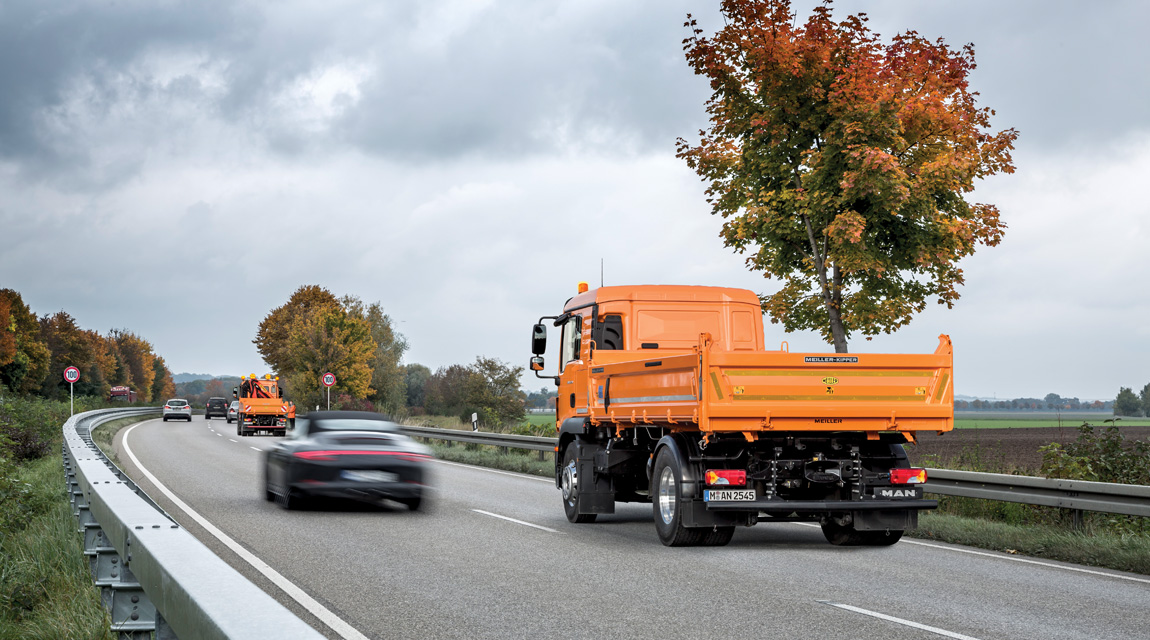Driverless trucks ready to hit the highway!

Highway maintenance personnel take their lives into their own hands – quite literally – when working on German highways. As we all know, many highways in that country have no speed limit – meaning that these highways full of hurtling missiles.
The consequences of this situation are dire; deaths are common. In fact, German researchers discovered that road service staff face a risk that is 13-times higher than equivalent workers (who are doing similar jobs, but not working on highways).
Enter the Automated Unmanned Protective Vehicle for Highway Hard Shoulder Road Works (or aFAS), which has been developed by MAN and various industry partners (BASt – Federal Highway Research Institute, Hesse Mobil – Road and Traffic Management, Karlsruhe University of Applied Sciences, Technical University Braunschweig, ZF, Wabco and Bosch).
The aFAS – the first Level 4 autonomous vehicle on European roads – is a driverless truck that follows a lead vehicle on the side of a highway. It travels at a maximum speed of 12 km/h.
The concept is both impressive and brilliant. It could save many lives, too, because, when an accident does occur, it is always the rearmost maintenance truck that’s involved. Some 50 of these trucks are written off in the state of Bavaria each year alone!
The aFAS is one of the finalists in the inaugural Truck Innovation Award (read more about this new award on page 14 of this issue of FOCUS). I’m one of the judges within this awards programme. Accordingly, I flew to Austria recently to see the truck in action – and it’s massively impressive.
I sat in the rearmost maintenance truck and it’s quite spooky, sitting in a truck that has no driver behind the wheel, but, according to the uber clever engineers from MAN, it’s very safe for fellow road users. If, for instance, a person or vehicle passes in front of the driverless truck, it will simply stop.
This revolutionary truck (which truly is massive news) operates in one of two driverless modes: follow or coupled. When operating in follow mode, it trails the lead vehicle by 100 m. When in coupled mode, it is 10 m behind the lead vehicle.
The latter is used when exiting the highway, for instance (the two vehicles need to be close together; while perfectly safe, it’s not optimal for another vehicle to jump into the gap between the two trucks … because then the driverless truck will stop).
Development of the aFAS started four years ago, and it been tested extensively on German highways – without any incidents or accidents. One of the other judges asked a particularly interesting question during our visit: “What happens when other road users see that a driverless truck is on the highway? Don’t they become alarmed?” The response was interesting. Apparently no one ever notices that there’s no driver behind the wheel. Which is somewhat a pity – it’s truly amazing to see the autonomous truck do its thing!
Another interesting question was posed, too: “What about jobs? Surely the aFAS will cause job losses?” Actually not. The aFAS is actually driven to the highway by a regular driver, who then hops out of the truck and performs maintenance on the highway. So, it’s a case of better utilisation of staff members – which is a good thing considering the massive driver shortage in Europe (trucks are standing because companies cannot find drivers).
MAN is ready to supply the aFAS to customers. “There’s great interest in the vehicle. We just need existing legislation to be adjusted,” Martin Böckelmann, MAN’s head of product communications, told me.
So, the next time you’re in Europe and you spot a highway maintenance crew, look into the cab. Chances are that the truck won’t have a driver. Now isn’t that just amazing?
Published by
Charleen Clarke
One Comment
Leave a comment Cancel reply
focusmagsa





For some reason, this doesn’t sound safe to me.